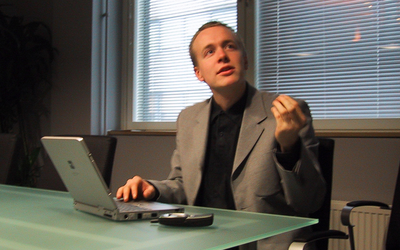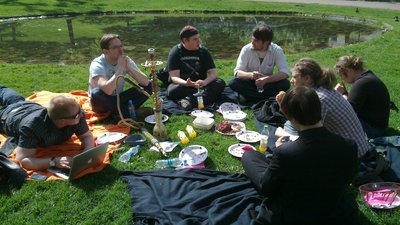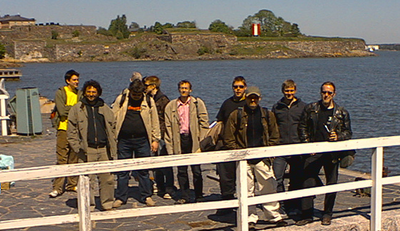Ten years of Nemein

Today it is ten years since my company, Nemein, started operating. Our team had been doing the internal Midgard-based information systems at Stonesoft, but as parts of that company were being sold, our team would've been split up. So instead we started our own business with Henri Hovi and Johannes Hentunen, with the idea that our Midgard expertise would be useful to a wider market.
The best laid plans
The initial plans were made at a Starbucks on New York's JFK airport while waiting for a flight to Atlanta, but their realisation had to wait until I finished my military service on the latter half of 2000. When I got rid of the bazookas and uniforms, we registered the company, wrote some business plans and started looking for seed money to get our business started. We were quite young then, and it was interesting to run around Helsinki talking to investors.

How did these plans look like? Our initial idea was to get into the fashionable SaaS (or ASP, as it was known then) business by building collaboration tools on top of Midgard. The first product was a document store intended for the construction industry. With this system all plans and other documents related to a building project could be easily stored and accessed. This is how we described ourselves:
Nemein Solutions is the leading provider of Open Source Midgard software for mobile collaboration and information management.
But as plans go, this had to soon change due to the IT bubble being burst. To quote von Moltke:
No plan of operations extends with certainty beyond the first encounter with the enemy's main strength
In spring 2001 IT bubble burst, and we suddenly found ourselves sitting in the office with all our projects being abruptly frozen. Around the same time our seed investor got embroiled in some large-scale customs lawsuit, and so not much help was to be expected from them. This meant we couldn't continue with our original plans, and instead had to start generating cash flow, quickly. Luckily Midgard was (and is!) a quite capable web framework, and so we had the option of going into the CMS business.
Nadmin Studio
Midgard's user interfaces back then were not very appealing, and so our first task was to go shopping for the CMS UI. There were two good options available: Nadmin Studio from Hong Kong Linux Center, a web based CMS and small business networking tool running on top of Midgard, and a Windows-based Midgard editing tool from DataFlow. As we were much more of a Linux shop, we went with Nadmin. It was quite a cool system, a customized Red Hat Linux install that set up not only Midgard and the web user interface, but also things like LDAP and IMAP servers talking directly with the Midgard database. And it had a quite nice WYSIWYG editor for people writing content on the web pages. We quickly became their reseller for Finland. Yes, back then you could get Midgard in a box (and even CD):

Having settled the tool question the next issue was finding clients. We took a list of hundred largest companies in Finland and basically called each of them, proposing a demo. We also approached several "new media companies" in order to see if they wanted a technical partner. Around these times our CEO Petri Kuusela also figured that we'd be a lot more convincing consultants in sweaters instead of Hugo Boss suits, and so the look of the company changed.
Through these efforts we were able to get some of our first and longest-term customers, including this one:
HELSINKI, Jun 12th 2001 -- Nemein Solutions helps Everscreen Mediateam, a Finnish multimedia company implement the Nemein.net Content Manager product to power Motiva's web services. Everscreen's and Nemein's cooperation provides Motiva with up-to-date and easy to use web sites.
Around this time we moved from the small four-desk office in central Helsinki to a much bigger place in Haukilahti, Espoo. My time was mostly spent motorcycling from one demo to another, as our two sales guys kept me so busy that on most days I didn't have time for a lunch break, and much less for actually writing code. The cash flow generated there helped to keep things running, but as usual, possibilities for product development suffered. This is called the Consulting Trap:
...Once the consultancy money rolls in, it is hard to give up. Like an addiction.
I spent years thinking just six more months, then I'm going to quit and work on my µISV project.
Nemein.Net
Consulting isn't such a bad business to be in. As long as the things you do produce value for customers it can be lucrative and interesting. But still the idea of having actual products was kept alive, and a bit later we built Nemein.Net, a project management tool for consulting companies. We changed the business model a bit, instead of providing hosted services we leased some industrial-grade servers to our clients with the software pre-installed. A cluster of engineering companies bought that, and as far as I know some of them still run it. Datex-Ohmeda was another customer, but they were later bought by General Electic.
"For our project work it is very important to reduce management overhead and enable real-time tracking of project status. The Nemein.Net Projects suite provides a good match for these criteria," says Bror-Eric Granfelt, R&D Manager at Datex-Ohmeda.
Free Software company
In 2004 we open sourced the Nemein.Net suite, now renamed to OpenPSA. This was done as part of the 5th anniversary celebrations of the Midgard project. By this time Nadmin Studio had also been GPLd and renamed to Aegir CMS. So suddenly we were a pure Free Software company. We quickly started adopting MidCOM, the emerging MVC framework for Midgard and PHP. MidCOM was produced initially by the German ISP Linksystem Muenchen, but very soon Nemein was the primary contributor.
The company structure changed, and we decided that instead of having a traditional office with desktop computers, it'd be better to be more location independent and work where our customers were. So we got a small office from the Innopoli business park mostly to facilitate Rambo, and the rest of our people were moving around. Once a week we had a coordination lunch meeting in Restaurant Mount Everest to keep the group spirit going. Some of that tradition has stayed.

Around this time we also started the switch on our workstations from HP's Linux laptops to MacBooks. This wasn't really a conscious strategy, but instead mandated by my laptop breaking a day or two before a training trip to South Africa. Back then Linux on laptops was still a quite cumbersome setup, and I needed a Unix machine where our software would run, quick. Later on I've returned to running Linux on my own machines, but most of the company still works on OS X.
The Finnish Centre for Open Source Solutions (COSS) was formed in 2003, and we soon joined up. A forming network of free software companies in Finland was good for both publicity and getting new projects. OpenPSA gained a boost there:
Collaboration with Nemein went well. Right from the beginning they were able to state their views clearly and backed by facts. We immediately understood how OpenPSA works, what customizations would be needed, and how much they would cost. Unfortunately we cannot say the same of all other solution providers, says doctor Ville Ojanen.
Dreams of networked business
Another interesting opportunity that came from the COSS network was the EU-funded Digital Business Ecosystems project. The project fit quite well in my view of the need for enabling cooperation between small companies in Europe, this time through having business systems talk to each other over a peer-to-peer network.
To realise this dream we connected our OpenPSA system into the ecosystem, enabling companies to fluidly share tasks, workflows and hour reports over the network. Unfortunately not much came out of that. A bit later the maintenance of the OpenPSA project was switched over to Content Control from Germany.
A later iteration of similar ideas was Ajatus, an experimental project to build a "personal CRM".
"Companies that don't realize their markets are now networked person-to-person, getting smarter as a result and deeply joined in conversation are missing their best opportunity." - The Cluetrain Manifesto, these 18.
Remember a time when you needed to share a document with a business partner, colleague or a customer? The CRM should make this easy without requiring complex IT integration setups or the disconnectivity of emailing files.
Getting into position
Several Nemein people have been active motorcycle travelers. As all our projects were more or less visible on the web, this brough the question of location sharing into the picture. For the Death Monkey project in 2006 we built a set of location-aware features that enabled us to visualize the location of each participant on a map, and easily calculate distances to Gibraltar.

At that time using maps on the web was also growing, and so we stepped into the emerging business of neogeography. Over the years we've evangelized the usage of location information on Linux desktops, built weather-aware clothes catalogues, facilitated publishing open data of campus maps and made it easier to catch a tram. This is still one of the areas online that I find most interesting.
Growth and mobility
Over the years Nemein's business has been growing at a steady pace. Now we have a nice small office in the Hietalahti area of Helsinki, and serve quite a bunch of interesting, large Finnish customers in the CMS space. A major milestone for the company was achieving AAA credit rating back in 2007:

Ignited by Apple's iPhone launch, the mobile ecosystem has been a very interesting area to operate in. To be part of it, we built the community infrastructure for Maemo, Nokia's emerging mobile Linux platform, and also got involved in the MeeGo project. But now in the age of burning platforms the future of that business is in question.
The Midgard way
The Midgard content repository and web framework have been a constant core part of our business for the whole history of the company. Everything we've built has been running on top of it. Has this been a wise choice? In the course of ten years, the web landscape has changed quite a bit. While Midgard itself has stayed current through constant development and refinement, hundreds and hundreds of competing systems have risen up, some of them becoming very popular compared to us. And yet we have stayed the course.

Midgard, especially in the latest iterations, is an excellent tool for running information-rich systems. It has a very nice user interface and an elegant web development framework. These are tools that I feel have lots of possibilities still ahead of them. Some of the design decisions done in the early days of the project, like integrated support for multi-site hosting, and for multilingual content, are things that now power some of our most important customer deployments
But at the same time I've learned that especially for smaller open source projects like us, the monolithic "all or nothing" approach is not very healthy. Frameworks keep us apart, while libraries allow us to share our code and experiences. This is resulting to collaboration with other projects on many levels, from a shared PHP ecosystem managed through the Apache Software Foundation, to common tools for decoupling the Content Management experience. Linked Data also plays a large role here.
To wrap it up
Ten years as an entrepreneur is a long path. Financially it may not have been as rewarding as we initially thought it would be, but experience-wise it has been astonishing. I've been part of building many challenging business-critical systems, learnt a lot of things, and given talks in dozens of conferences all around the world. It is hard to see as varied and interesting possibilities in regular employment.
Thanks to the whole current Nemein team, and the people who've been here before for all the awesome work done over these years. You rock!

